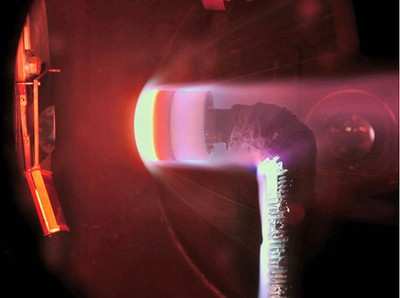Company Becomes Only The Second Commercial Source For The
Record Holding NASA-Developed Material
 Space Exploration
Technologies Corp. (SpaceX) has overcome a significant technical
milestone in the development of its Dragon spacecraft with the
successful arc jet testing of PICA-X high performance heat shield
material. Subjected to temperatures as high as 1850 degrees Celsius
(3360 degrees Fahrenheit), the tests simulated the reentry heating
conditions that will be experienced by the Dragon capsule. Panels
of the high performance carbon-based material will protect cargo
and crew during the spacecraft's return from Earth orbit.
Space Exploration
Technologies Corp. (SpaceX) has overcome a significant technical
milestone in the development of its Dragon spacecraft with the
successful arc jet testing of PICA-X high performance heat shield
material. Subjected to temperatures as high as 1850 degrees Celsius
(3360 degrees Fahrenheit), the tests simulated the reentry heating
conditions that will be experienced by the Dragon capsule. Panels
of the high performance carbon-based material will protect cargo
and crew during the spacecraft's return from Earth orbit.
SpaceX developed the ability to manufacture PICA-X with the
assistance of NASA, the originator of PICA (Phenolic Impregnated
Carbon Ablator). The "X" stands for the SpaceX-developed variants
of the rigid, lightweight material, which has several improved
properties and greater ease of manufacture.
"We tested three different variants developed by SpaceX," said Tom
Mueller, VP of Propulsion, SpaceX. "Compared to the PICA heat
shield flown successfully on NASA's Stardust sample return capsule,
our SpaceX versions equaled or improved the performance of the
heritage material in all cases."
The tests were conducted at the Arc Jet Complex at NASA Ames
Research Center, Moffett Field, California, which has a rich
history in the development of Thermal Protective Systems for NASA
spacecraft, including Apollo, Space Shuttle, and robotic missions
to Venus, Mars, and Saturn. The NASA Ames Arc Jet Complex is
uniquely capable of simulating conditions experienced during
reentry.

"The arc jet tests represent the culmination of an aggressive
six-month development effort, and our goals have been met or
exceeded," said Elon Musk, CEO and CTO of SpaceX. "Dragon will be
the first craft to return from Low Earth Orbit using a PICA-based
thermal protection system."
SpaceX is only the second commercial producer of a PICA-based
material. All of SpaceX's initial production will be used for
domestic in-house applications including the heat shields of the
Dragon spacecraft, and the Falcon 9 second stage, which is designed
to return from orbit for recovery and reuse.
The inaugural Dragon spacecraft flight is scheduled for 2009
aboard SpaceX's new Falcon 9 launcher.
The Dragon capsule will enter the Earth's atmosphere at around 7
kilometers per second (15,660 miles per hour), heating the exterior
of the shield to up to 1850 degrees Celsius. However, just a few
inches of the PICA-X material will keep the interior of the capsule
at room temperature.

In January 2006, NASA's Stardust sample return capsule, equipped
with a PICA heat shield, set the record for the fastest reentry
speed of a spacecraft into Earth's atmosphere - experiencing 12.9
kilometers per second (28,900 miles per hour). SpaceX's Dragon
spacecraft will return at just over half of that speed, and will
experience only one tenth as much heating.
 ANN's Daily Aero-Linx (05.02.24)
ANN's Daily Aero-Linx (05.02.24) ANN's Daily Aero-Term (05.02.24): Touchdown Zone Lighting
ANN's Daily Aero-Term (05.02.24): Touchdown Zone Lighting Aero-News: Quote of the Day (05.02.24)
Aero-News: Quote of the Day (05.02.24) ANN FAQ: Contributing To Aero-TV
ANN FAQ: Contributing To Aero-TV NTSB Final Report: Cirrus Design Corp SR20
NTSB Final Report: Cirrus Design Corp SR20





